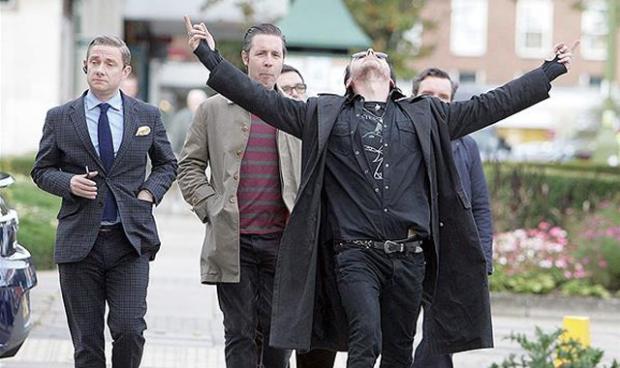25 Points: Memories of Underdevelopment
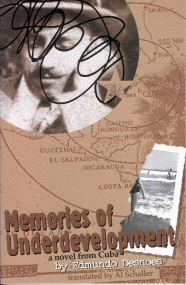 Memories of Underdevelopment
Memories of Underdevelopment
by Edmundo Desnoes, translated by Al Schaller
Latin American Literary Review Press, 2004
110 pages / $15.00 buy from LALRP
1. Memorias del subdesarrollo. Or call it Inconsolable Memories, which shows up in the subtitles of Tomás Gutiérrez Alea’s film adaptation, and is itself a wish taken from Hiroshima, Mon Amour, one of the narrator’s favorite movies. J’ai désiré avoir l’inconsolable mémoire.
2. I’ve looked up “underdevelopment” in the dictionary twenty times since seeing the film and reading the book. I’m waiting for the definition to say: a better word for this word is subdesarrollo.
3. The film was shown during Revolution in the Air: The Long Sixties.
4. The longer the 60s, the shorter the 50s and 70s.
5. We’re talking about how to get to Cuba the way our grandparents talked about how to get to the suburbs and their parents wondered how to get west. “I already know the United States, but what will happen here is a mystery to me.”
6. The author photo shows Edmundo Desnoes with full white beard, pipe in mouth, arms over his head in a pose of relaxation, not surrender. “The first responsibility of a writer is to survive.”
7. Reading books after seeing the movie. I made this mistake with The Firm. Even though I find Jeanne Tripplehorn attractive, and love typing out her name, Abby McDeere is shapelier on the page.
8. The novel’s first person antihero, Sergio Malabre, has less poise/élan than a Grisham creation (or Tao Lin) and believes himself, like so many first persons, to be the last man. He’s not a drinker but there’s probably something wrong with his liver. With his wife and family off to America he decides to stay in Cuba, an island he calls a trap, and to live amongst a revolution he calls a tragedy. On a crowded bus he feels like slime. “I am 39 years old and already an old man. I feel stupid. More rotten than mature.” The theme of rottenness in Memories of Underdevelopment is slightly less romantic than DeLillo’s “apple core going sepia” at the close of Underworld. Sergio, our rotten and rotting antihero, is play acting through the period drama of the future. His actual life is something Donald Draper will make a Park Avenue Sad Face about. He does not want what he wants. He does not want the historical anchors his country offers him. In protest, he removes the timestamps from his journal midway through the novel because he believes dates are meaningless. July 26, 1953. April 17, 1961. October 14, 1962. He’s a cultured, good-looking, overripe intellectual educated in New York and Paris (he’s done the 90 miles; no matter how far away it is, it’s always the 90 miles) who wants to know less, who wants to be stupider. #bayofpigs #Octobercrisis #CMC #gameofchicken.
9. As self-aware as Ben Lerner’s cipher in Leaving the Atocha Station, who, following the 2004 Madrid bombings, finds the air alive “less with the excitement of a period than with the excitement of periodization.”
10. Sergio, on a walk through the Hemingway house museum: “Americans have an artificial smell, and the Russians stink.” READ MORE >
September 12th, 2013 / 3:08 pm
25 Points: Creature
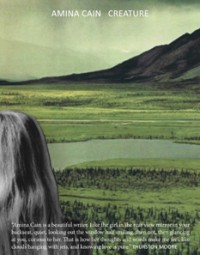 Creature
Creature
by Amina Cain
Dorothy, a publishing project, 2013
144 pages / $12.20 buy from Dorothy, a publishing project
1. I am ashamed of what I think about book reviews.
2. “I’m […] ashamed of what I think about literature—I can only open up to a few people in this way.” So says the narrator of “The Beak of a Bird,” the fourth short story in Amina Cain’s Creature (Dorothy, 2013). For now, I am hovering 40,000 feet above the Earth.
3. My thoughts about texts exist as emotional impressions, and what interests me most as a reader is ambience and affect—words as molecules of emotion, states of agitation, decorative illuminations, background noise. Readerly impressions in my bones are intimate like pages; they are, as in Creature, “the place where [my] life unfolds.” I want to recite my Creature to you, but instead draw inward toward the place where my body’s median axis, its midline, is askew.
4. Preoccupied with atmosphere and feeling as I am, I am ashamed of what I think (or don’t think) about literature, and so I choose not to write about books. But Amina Cain’s Creature is different: Amina Cain’s Creature resides out of harm’s way, although it exists in savage and erotic twilight. “I expressed myself through the violent putting away of a pan.” “Myself, alone, in my bed, is a story.” “Write about the arm when the whole body is being abused.” “We watch something violent on my laptop. It will help me wear this dress.” In this darkness, I read and write and think-along, and feel involved in every sentence. This involvement is key to my wanting to recite my Creature. Involved in it, I am pleased to feel ashamed of what I think.
5. Creature begs to be watched. Passing over one’s horizon of attention, the book is a meditative practice, which is not to say Creature is necessarily a meditation, for a person does not read Creature so much as she suspends it in space. 40,000 feet above the Earth, she observes its sentences, lines of thought that move across the mind, and breathes them in and out. There are momentary pauses of deep calm. It is likely the mind wanders. And as Creature unravels, the body sheds itself.
6. I am ashamed of my physiological responses to literature. See Exhibit A, which I am sorry to describe. In this disgraceful scene, I am hovering 40,000 feet above the Earth reading Creature’s “Attached to a Self.” I am attempting momentary pauses of deep calm. In the midst of this exercise, I cross a passage wherein Cain refers to a Benedictine monk: “The word is supposed to send a person into great silence,” she writes. “Just a little bit of reading is enough.” I suspend the statement in space, let it resonate. My eyes trace the sentence and tear.
7. Am I crying because of the story, someone asks, or because of the space?
8. Am I crying because of the space, I wonder, because this is the space where my life unfolds?
9. And is it really me if I’m not there?
10. To answer these questions for you, let me describe where Creature rests in my body—deep within my thoracic spine, in the middle of my vertebrae alongside photo booth-sized images of unrequited knives. I am conscious of it as I watch my body read. Its language moves and settles. This process of watching—as opposed to thinking—may seem enigmatic. It is. READ MORE >
September 5th, 2013 / 4:51 pm
25 Points: The Rifle
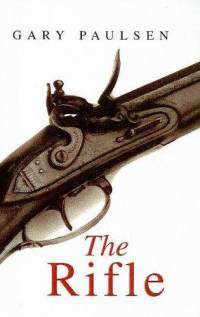 The Rifle
The Rifle
by Gary Paulsen
Laurel-Leaf Books, 1995
105 pages / $6.29 buy from Amazon
1. For my fifth grade class, Gary Paulsen was considered the pinnacle of literary merit. Second only to R. L. Stine.
2. Most people I talk to remember reading Paulsen’s novel Hatchet pretty well, but I’ve yet to meet anyone who remembers The Rifle.
3. The Rifle is about a man who carves a muzzle-loaded rifle out of a tree branch and spends a long time on it. He then sells it to a Revolutionary War soldier who dies of dysentery after killing a lot of British officers. Then an old man buys the rifle. He’s lonely and his life sucks, and the boy who lives across the street’s life is lonely, too. The boy’s dad is a trucker and doesn’t care about him. Then the man’s gun accidentally fires and kills the boy.
4. I lied about that.
5. I think in my memory I joined this novel with another novel that I read that same Summer as a kid. I dreamed an entire subplot about the little boy and his relationship with his trucker dad, writing him postcards and eating ice cream.
6. I think that book was written by Beverly Cleary.
7. She was pretty well liked in my grade school, too.
8. Here’s the real plot of The Rifle:
9. The book is even sadder than I remembered.
10. The muzzle-loaded rifle was made by a dedicated gunsmith and he did sell it to a sharpshooting soldier, but after the soldier dies of dysentery, the gun is stuck in an attic until a guy finds it and sells it to a dude at a gun show. The gun show dude is your stereotypical stand-yer-ground-pry-em-out-of-my-cold-dead-hands- lives-in-a-van-off-the-grid-type dude. This gun guy drinks a lot of beer and the omniscient narrator tells us that later he gets stomach cancer and dies. This stomach cancer guy’s van breaks down and he trades the rifle and an Elvis painting on velvet to a mechanic for van parts. The mechanic takes both the gun and the painting home and places them on his mantel. Then one day, he’s lighting a fire in the fireplace and a spark from the fire lights some old powder in the gun and it goes off and the bullet flies through the house and kills a little boy who lives across the street. Then the novel discusses how the loss of the little boy’s life ruins everyone else’s lives. READ MORE >
August 29th, 2013 / 2:28 pm
25 Points: City Water Light & Power
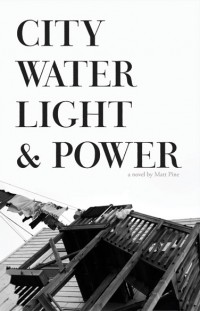 City Water Light & Power
City Water Light & Power
by Matt Pine
Cairn Press, 2013
180 pages / $18.00 buy from Amazon
1. I’m in awe of Matt Pine’s prose style. A lake has “the same texture and tone as ink spilled onto silver.” A black dress has “the same cling and quality as plastic wrap on American cheese.” These similes give me goosebumps.
2. The frisson of encountering high style in a world that no longer much values it.
3. City Water Light & Power explores the angst of being young in the city and not knowing the score. It’s about twentysomething Chicagoans figuring out how to survive in body and soul — the alternatives, in this novel, are selling out or breaking down, in bars where salaries are “revealed like flashed genitalia” or in alleys where it’s “spiritually dangerous walking there dispirited after dark.” Your choice is to be one of the manipulators, or someone who walks without a destination — both flavors of desperation.
4. Chicago is a character in this novel. A machine whose workings are dangerously hypnotic.
5. A study of corruption and alienation that gives me that sense of a ruthless and inscrutable society I get from Fitzgerald, say, or Salinger. Matt Pine writes of venality in a tone of innocent fascination — he is sensual, aggrieved, and mystified by ordinary life, in a classic American tradition harking back to the Puritans.
6. The demolition of a dive bar stands for what’s being lost. The bar is called Lewis & Carol’s… perhaps to suggest a world down the rabbit hole or through the looking glass?
7. I like it that this bar seems to be the only thing keeping Jake from becoming an alcoholic – after its destruction, Jake takes to drinking outdoors. Somewhat illogically since the novel acknowledges there are other bars in Chicago – one might even say too much of this novel takes place in bars… But these bars are full of phonies, not like Lewis & Carol’s, which stands for community.
8. Many first novels by men include a dazed and confused main character. In this case, Jake. His job involves talking to imaginary customers. His free time is spent with an imaginary friend, a woman visible just to him, who communicates only through mime and gymnastics and might work better in a movie, a mute hallucinated character being tricky to pull off in a novel…
9. Adrian is a character who success brutalizes. He is seeking the wrong nourishment, acquiring what David Mamet has called “the canting language of the real-estate crowd.” There’s beauty in the process of making ugliness happen, Pine suggests, but it’s a lonely beauty.
10. Jake is a half-hearted preserver, Adrian a developer. Jake on Chicago – “But I wonder what it is we’re wanting after. If it’s really the city, I mean. Do we want more of it, or do we want what it was? I’m sorry. I’m not articulate today. I guess I wonder why we have to fight the city for it to stay itself? Because isn’t that stopping it from being itself? And yet it’s so glorious.” Adrian on Chicago – “What would lure a boutique? How many patios were necessary to make an enclave of patios? Did condos come before cuisine? But then who would move into this wasteland? But why would you open a business where no one lived? It all seemed to leap out all at once, all the parts dependent on all the parts, like a stone archway. But also like an archway, there must be a way to build one.” READ MORE >
August 27th, 2013 / 6:45 pm
25 Points: The Unknown University
 The Unknown University
The Unknown University
by Roberto Bolaño
New Directions, 2013
766 pages / $39.95 buy from Amazon
1. I’ve a strange attachment to Roberto Bolaño. One of coincidence and timing and love.
2. The Savage Detectives came out in the US six years ago, the same week I decided that—yeah, dammit—I was going to do an MFA.
3. I finished my MFA not too long ago (May-ish), just as the Bolaño Library seems to have exhausted its basement of posthumous manuscripts with The Unknown University, “a deluxe, bilingual edition of all the poems of the great Roberto Bolaño.” (Or so says the flap).
4. The Unknown University, really, reads more as a manuscript of notebooks. Poems incorporate drawings, caesuras become page-breaks, forms change again and again and again. At first, it reminded me of Jack Kerouac’s Mexico City Blues, in which every page of the book was in fact a typed page of a notebook’s musings. This feels like that, but rewritten from notebooks to computer and revised.
5. It’s 700+ pages and irresistible to a Bolañophile like me. A short story that recently ran in the New Yorker appears (“Mexican Manifesto”), as does the whole of the novel Antwerp, albeit in somewhat different form (and under the title “People Walking Away”). I didn’t do a full index-to-index comparison, but it also seems the whole of 2008’s The Romantic Dogs appears in a scattering throughout Part Three.
6. Despite these inclusions, though, The Unknown University isn’t a collection of previously-published books, like other “complete” collections can tend to be. (Just above my Bolaño shelf at home are the Collected Lydia Davis and Amy Hempel, which are exactly that).
7. Some such collections, like Jack Gilbert’s or Richard Hugo’s, have a section of “uncollected” pieces that follow the chronological reprintings. The Unknown University is sort of like one big “uncollected” section, but one that the author took the time to fashion into something that can live alone.
8. According to the note from the heirs: “The present edition corresponds exactly to the manuscript we found (with only a few minimal corrections taken off of his computer). Roberto himself dates it to 1993.”
9. These are early writings. An author’s note lists the completion of some sections as early as the 1970’s, when Bolaño was just Roberto, one of the boy-poet idealists he takes so often as subject in his fiction. In several poems he makes reference to his age (typically 26 or 27), which would have been around 1979-80.
10. One could imagine The Unknown University as the texts Bolaño wrote during the time of his writerly maturation, for what many now is the MFA. READ MORE >
August 22nd, 2013 / 11:00 am
25 Points: Brushes With
 Brushes With
Brushes With
by Kristina Marie Darling
BlazeVOX [books], 2013
50 pages / $16.00 buy from BlazeVOX or Amazon
1. This is Kristina Marie Darling’s 11th book of poetry; she is not even 30 years old yet.
2. Darling eschews traditional forms of poetry in favor of her own unique formal constraints: the use of footnotes, appendixes, images, definitions, bracketed verse, and erasure poetry. However, in Brushes With, Darling adds a new form to her repertoire: the narrative prose poem.
3. The collection begins: “We were no longer in love. The sky, too, was beginning to show its wear.” From this point forward, readers are plunged into many complex layers of the rubble of abandonment and loss.
4. The footnotes serve as historical commentary on the prose text. This makes for a matrix-like experience. We are reading a person’s intimate words, but we also know that this text has been abandoned, then found, then studied, then put on display. This technique makes the experience of reading the prose poems feel illicit in some way. We are peering into a labyrinth of secrets that are not meant for our eyes, yet are now uncomfortably preserved and public.
5. Even while reminiscing on the relationship before its end, the speaker foreshadows doom: “You told me there was dark matter I couldn’t see. That every star is a dead star.”
6. The imagery, like the one above, proves to be richly complex. All stars are dead; therefore, that which enchants us, that which we wish upon, that which we map out, gaze upon, pray to, is also doomed. In every romantic union, there is something dark that we don’t see coming, yet we should be aware that it’s there.
7. In “Feminism,” the speaker states: “I began to realize the significance of this gesture. What is love but a parade of memorable objects, a row of dead butterflies pinned under glass?” Ouch!
8. The speaker’s take on love is relentlessly jaded, yet she comes to sharp edged truths. What is love but our desire to possess, collect, admire. Yet, in doing so, we must sacrifice the subject’s life.
9. Footnote 18. ‘This statue of the Holy Mother would later be found headless in a tiny museum in northern France.” Once again, we have worship, mementoes, collection, ownership—all leading to destruction. Facelessness.
10. The marriage documented in the book unravels due to affairs. READ MORE >
August 20th, 2013 / 5:22 pm
25 Points: Room
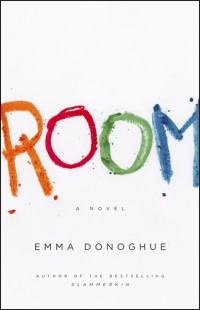 Room
Room
by Emma Donoghue
Little, Brown, 2012
384 pages / $7.99 buy from Amazon
1. Not many authors could write believably from a child’s point of view and still provide such credibility and license to the narrator. That’s what you need to know most readily to begin this book.
2. Concepts like “TV People” and rain being nothing more than a blurry veil over Skylight–a saddening slap in the face realization for readers that this is really happening.
3. It is striking, the “savant” nature of the little boy – how he can be so well-educated with so few resources, and yet so ill-informed on social protocol and other “real world” mechanisms. It could be argued, though, that he is in many ways better off than a “normal” child.
4. This reviewer recommends reading this book aloud or obtaining an audio copy. Hearing the dialogue between the mother, the child, and Old Nick is especially gripping.
5. It is an incredible struggle not to be angry with Grandma. Grandma’s love for Ma exists but does not inspire.
6. The poem excerpt at the beginning. Yes.
7. The way the child refers to inanimate nouns as personified, proper-nouned entities provides reality to the voice of the child narrator, but also speaks to the attachment any human would have to inanimate things in a situation such as “Room” describes. It’s a very subtle way to calcify the experience for readers.
8. Page 67, “Princess Diana” “Should have worn her seat belt” — one of the funniest sidesteps in conversation throughout the novel, albeit cryptic.
9. The experience of the Indian family and their dog finding Jack in the park elicits severe, literal nausea. For the first time, picturing Jack outside of Room and experiencing what he must look like up next to other humans, other children – pure nausea.
10. There is a distinct failure to understand that radiates through the hospital. As such, the reader will experience a certain kind of rage and a certain kind of advocacy for Ma and Jack. On Donoghue’s merit, this is a great mechanism for roping readers in more tightly, On the other hand, the injustice provokes readers to consider how often and to what degree these situations are marred by “professionals” in our nonfiction world. READ MORE >
August 15th, 2013 / 12:06 pm
25 Points: Petrarchan
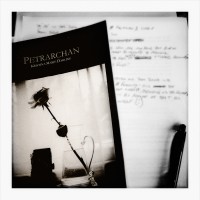 Petrarchan
Petrarchan
by Kristina Marie Darling
BlazeVOX [books], 2013
72 pages / $16.00 buy from BlazeVOX or Amazon
“Within every box, I found only compartment after compartment.”
1. Petrarchan is Kristina Marie Darling’s 8th book, published by the ever controversial Blaze Vox Books. (Yikes. Remember that whole thing? I still have love for the Vox, though.)
2. Much in the way she “took liberties with H. D.’s letters” in THE BODY IS A LITTLE GILDED CAGE, Darling uses ekphrasis, careful appropriation, erasure, and the work of Petrarch and Sappho (the latter, via Anne Carson’s translations) to achieve her grand illusion.
3. Kristina Marie Darling’s voice as a writer is unmistakable and unshaken regardless of mode or form. Of this, I am thoroughly convinced.
4. In fact, one thing that has repeatedly struck me about Kristina is how much larger in stature her writing voice is than its author. To be clear, this is not to reduce her as a person, but to exemplify her work as a force. Often, in an effort to amplify one’s voice over the din of modern media, the artist must become a personality first in order to gain potential interest in the work. Unfortunately, it becomes easy for the latter to suffer in the shadow of the former in the race. Darling reminds me that there is still a strong argument to be made as an artist for placing one’s ambitions squarely on the body of one’s art.
5. This is to say that I have no idea whose parties she attends, under which influences, et cetera, but I damn sure know when it’s her voice there on the page.
6. The reader will find in Petrarchan Darling’s familiar signature use of spare narrative and spectral imagery driving a carefully plotted course of marginalia and footnotes. To be fair, it is doubtful that anyone who is unconvinced or maybe even still undecided about her work in general will be swayed by Petrarchan. However, those of us who are believers or even simply interested parties will take comfort in knowing that what is gold still shines.
7. Tangentially, I have been thinking a lot about appropriation and erasure lately. As a writer who uses both at times almost criminally, I think a lot about what constitutes successful employment. After all, as some will invariably argue, can’t anyone do it? The short answer, of course, is yes. But to make a piece of erasure or other appropriation both successful and original despite its sources, I believe what the author chooses not to use, and why, becomes equal in importance to what is used, and how. The author must rely on the source text to some degree, but the artistic voice of the finished piece should stand on its own. Darling’s work—and Petrarchan is no exception—is as fine an example as any to underline these values.
8. I am thinking about corridors—hands and bricks or wood and the long-form sound of feet moving to some god knows where. I think about corridors a lot I think. I wonder if Kristina does too.
9. It is often easy to forget how the author implies a larger body of text with her use of marginalia as sparse narrative, set toward the bottom of the page, soaking up the white space of the specter it has picked apart.
10. Again, the ghostly presence hovering in the frame of the footnoted sections is largely the work of Francesco Petrarch, whose work I am largely unfamiliar with. I should really make it a point to change that. READ MORE >
August 13th, 2013 / 12:09 pm
25 Points: If You’re Lucky Is a Theory of Mine
 If You’re Lucky Is a Theory of Mine
If You’re Lucky Is a Theory of Mine
by Matt Mauch
Trio House Press, 2013
100 pages / $16.00 buy from Trio House Press or Amazon
1. “If you can’t see it then you’ll just never know,” the subject said, “I wish I could talk in Technicolor”
-Prologue
In the seconds before Matt Mauch’s If You’re Lucky Is a Theory of Mine, the book recounts experiments done with LSD in Los Angeles, California during the 1950s. The above is said by a housewife, who recently swallowed a glass of water, to a doctor that couldn’t see the wavelets of colored sand the air was drawing into her cheek, the immediate refraction of everything at double pulse.
The two-parted-ness of the housewife’s (a tupperware-d figure often “lacking power”) comment to the doctor (a figure which harnesses a kind of intelligence / power to see “unseeable” systems at work within our bodies) is as tender as it is dismissive. Equal parts frustrated and othering and already imagining a reality beyond reality into reality.
You’ll never get it, the woman says to the exploding planet and the doctor standing just in front of it, BUT if I could talk differently, better, with a lot of energy that made you forget what love even is, maybe you would. She wants to be a piece of transmission more than she wants to be withholding.
2. “Is looking traditional? I want a new technology of perceiving.” -Bhanu Kapil
This is happening and collapsing and it is everyday. There is new teal, which is sometimes just the old teal with different teeth weeping out of a curvature of bone. I love all the filters and various containers we are pushing and plowing expression into. When I think of all the language, all the Internet, all the books, I see we have many throats to shoot through and grow new throats with. I love that, sometimes, I just look at a strawberry and almost go into a coma from amazement.*
*THEY ARE FRUIT COVERED IN A THOUSAND TINY SHIELDS.
3 & 4. In larger size letters on a different precursing page, Billy Bragg says, from the tinny roof of a song called “Busy Girl Buys Beauty,” some language that brushes against the opposite side of the room.
“What will you do when you wake up one morning
to find that god’s made you plain?”*
What if we don’t ever get to be that housewife, seeing what others can barely dream of seeing? What if we are a housewife in CPA’s clothing**?
We take drugs to rail against this, drink to rail against this, almost touch the lumps in the paintings at the museum, stick our heads in vents, stick our arms out the cow window, write these poems, fuck these poets, fuck these non-poets, drive through Utah, do blood rituals, etc.
*Google asks me, “DID YOU MEAN…What will you do when you wake up one morning to find that god’s made you Palin?”
**On the way home from the Greyhound station, a guy who introduces himself as an auditor at Wells Fargo, asks me out. A very small part of the many reasons I immediately say no has a sliver of something to do with this. I know, in a more messy way than a clean sentence can represent, I don’t believe I’m plain. It’s despicable in some way, this thought.
5. If You’re Lucky is a Theory of Mine delves into the tension and overlapping (the vibrating fearjoy ping ponging back and forth / froth) between these two things. Are you normal or are you a seer / a sear?
“On the way down the mountain
you understand what the seer sage
is saying: that honey-smooth will always taste
good to the tongues in our ears,
and balancing expertly on the miniature avalanches
beneath each of your downward-angled steps
will go unheralded unless
you herald it, which isn’t in your make-up”
-There is the hiding. Here is the seeking.
6. The book is hesitant to distinguish whether you or I (Is a poet the housewife or the doctor?) are more likely to fall into one category or the other. It often wryly suggests we are about one step away from either or. Or rather, it points out at the complex phenomenon that witnessing can be and is. On one hand, you experience the spectacular kind of texture that knowledge possesses when seeing something for the first time or when seeing something for what feels like the first time.
“Glacier says
to Sun, “Saw a sparrow trying to crack
open the husk of a cicada on a driveway.
Never thought to use a driveway as a tool
like that.”
-It’s one thing to want one’s life to be fulfilling,
another to want it to be very long.
Even a glacier can suddenly feel small in the face of how great smallness can be.
7. The central poem, “It’s a planet, we’ve an age,” the book oscillates around is embedded within a section called, NORMAL. The section and the poem mean to closely examine, over the course of thirteen pages, the dead body of how normal normal ever is. We know that NORMAL is relative, that our conceptions and opinions of what it is is always changing, that many people you know would be the last ones to call themselves NORMAL. I remember the first time I realized that everyone saw those little neon flecks of color on the inside of their eyelids whenever they stared at the sun.
“It’s a planet, we’ve an age,” begins with emphasizing distance, the human presence as galaxial pinprick.
“On the third planet from the sun
you smoke a cigarette, or a joint,
slowly”
8 & 9. As the poem progresses, the you dissolves and reforms as an I. An I filled with specific choices and unchoices made via the ancestral blood whipping his own blood around. Each time I close my thinning lids, those bright sun flecks make new and different patterns.
What was distant and giving off those road waves you see on hot highways morphs into:
Horses, Juanitas, Arnie, who was identical to other Catholic school boys his age until a “horse’s shoe cut itself in miniature / in Arnie’s cheek,” Cancer, my dad’s dad, my mother’s father, Bob Marley, Budweiser, Jackie and I and eight, eight eight, the mailman with the abortion knowledge, “the photos we take of each other,” Apartment D, “the sweaters we wear / collect hairs,”“Like paper towels / we try to keep a little bit of everything we touch.”
The thing which continues to remind us of our distance, of a contained and clumsy universality we potentially share, is the continual mention of “the third planet from the sun.” The biggest zoo.
10. Is this where the idea of chance enters (because chance has to enter as soon as you read that title)? LOOKS AT ARNIE. LOOKS AT THE THIRD PLANET WHERE SOMEHOW A CELL GOT UP AND DID SOMETHING. Is this where the idea happenstance person and happenstance language having real effects on the present whatever enters? READ MORE >
August 6th, 2013 / 12:11 pm

